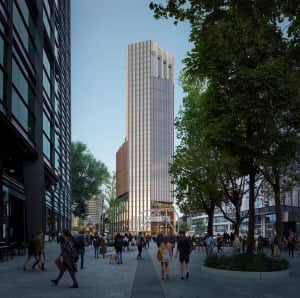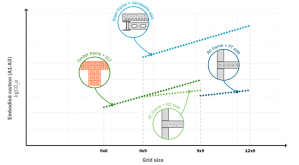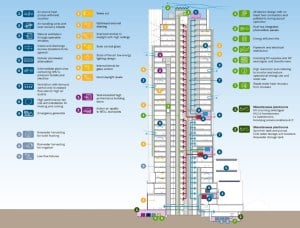Doing More with Less: Regenerative Design

Patrick Bellew
Chief Sustainability Officer
Patrick Bellew is a chartered environmental engineer with more than forty years’ experience in the design of high-performance buildings and systems, also Chief Sustainability Officer of SJ Group. Named one of UK’s Royal Designers in 2010, Patrick, Founding Director of Atelier Ten, was recently awarded the 2023 Fazlur R. Khan Lifetime Achievement Award by the Council for Tall Buildings and Urban Habitat (CTBUH).
It is no secret that the built environment industry is a significant contributor to the global carbon dioxide emission problem, considering both ongoing operational emissions and those associated with construction in the form of “embodied” carbon. With the current trajectory of climate change, it is imperative that we double-down on the challenge of our generation – to seamlessly integrate environmental and building systems with architecture.
Bridging Architecture and Engineering
Historically, engineering and architecture have been treated as two separate disciplines. In contemporary building design, the dynamic has shifted to one that is more collaborative, which is key to minimising the need for raw materials and carbon emitting energy. Architects and engineers must work in tandem through the early stages of designing a building to ensure that sustainable design thinking is thoroughly embedded into projects both conceptually and practically. For example, engineers, be they structural or environmental, may recognise and demonstrate that doing something a particular way will result in savings in operational energy, or in the carbon emitted when the materials are made. As one of the most carbon intensive sectors in the global economy, it is essential for us to examine how we can finetune existing designs to minimise our carbon usage.
Embodied carbon makes up a significant percentage of a building’s overall carbon footprint, this includes the carbon emitted in producing and transporting building materials. Minimising embodied carbon in a project requires a broad understanding of design impacts, construction techniques and materials production tapping into the expertise of both architects and engineers. Creating spaces for these discussions to happen allow us to collaboratively uncover ways to reduce the usage of carbon-intensive material through various design decisions.
For instance, simply changing the column grid inside a building from 12m by 9m to a grid that measures 6m by 9m reduces the carbon footprint of a building by 20%. Other avenues to reduce embodied carbon can include exploring low-carbon materials. When architects and engineers bring their collective expertise together to tackle these decisions, we can optimise the outcome of a building without sacrificing integrity, aesthetic, or sustainability.

Designing with Carbon in Mind
Conversations in sustainability have focused on operational carbon emissions, which result from the day-to-day operations and energy consumption of buildings. However, great strides have been made in reducing the carbon intensity of supplied energy through our de-carbonising power grids, resulting in operational carbon no longer always being the principal driver of lifetime carbon emissions, but embodied carbon. It is necessary to assess our design decisions moving forward to ensure that we are “carbon-effective” in our decision making, considering the balance of embodied and operational carbon over the life cycle of the building.
With the focus shifting towards reducing embodied carbon, the focus has turned back to the adaptive reuse of built assets, and we are increasingly focused on reworking existing buildings as opposed to knocking them down. The industry is working on finding new ways to adaptively reuse buildings, allowing for existing material to be kept, to reduce the emissions from demolition and replacement. The lowest carbon building is one that has already been built but upcycled, keeping existing structures intact while potentially extending them, or reconfiguring the interior or facade for it to meet the demands of modern life.


Manufacturers and producers are also beginning to make a concerted effort towards the rapid decarbonisation of materials in the supply chain. Producers of raw materials such as steel, cement and aluminum are focusing on decarbonising their products by improving the process at various stages, including extraction and processing. Alternative nature-based materials such as mycelium blocks are also a part of the development in this area, demonstrating the commitment of the built environment industry to move towards more sustainable practices.
Regenerative Design
As sustainability is slowly becoming the new norm, the next challenge is to take a step further and consider Regenerative design. Our current approach to sustainability lies within the question of reducing our environmental footprint, but regenerative design poses a different question: how can we design in a way that fosters feedback loops within the system, resulting in enriched ecosystems and enhanced environments?
While Singapore’s structures may not have been built with a focus on regenerative design, they inadvertently embody and exemplify some of the principles. Singapore’s buildings utilise green space ecosystems, reducing the urban heat island effect and reducing temperatures – which enhances local ecosystems and growth.
A regenerative approach in design becomes much more than simply reducing environmental damage, but about systems and structures that create a net-positive effect, working in parallel with nature to add back into the bigger ecosystem. The challenges and opportunities of regenerative design are equally great, requiring a rethink of many of the existing architectural and engineering approaches to sustainability – doing more and giving back to nature wherever possible. By actively embedding regenerative principles into the design process, architects and engineers can collaboratively create spaces that serve both human needs and the needs of the planet, contributing to a more sustainable future.
Hear more from Patrick Bellew
Tune in and listen to Patrick Bellew’s insights to a more regenerative approach in design and how the SJ Group is enabling these exciting projects in the podcast interview here.


